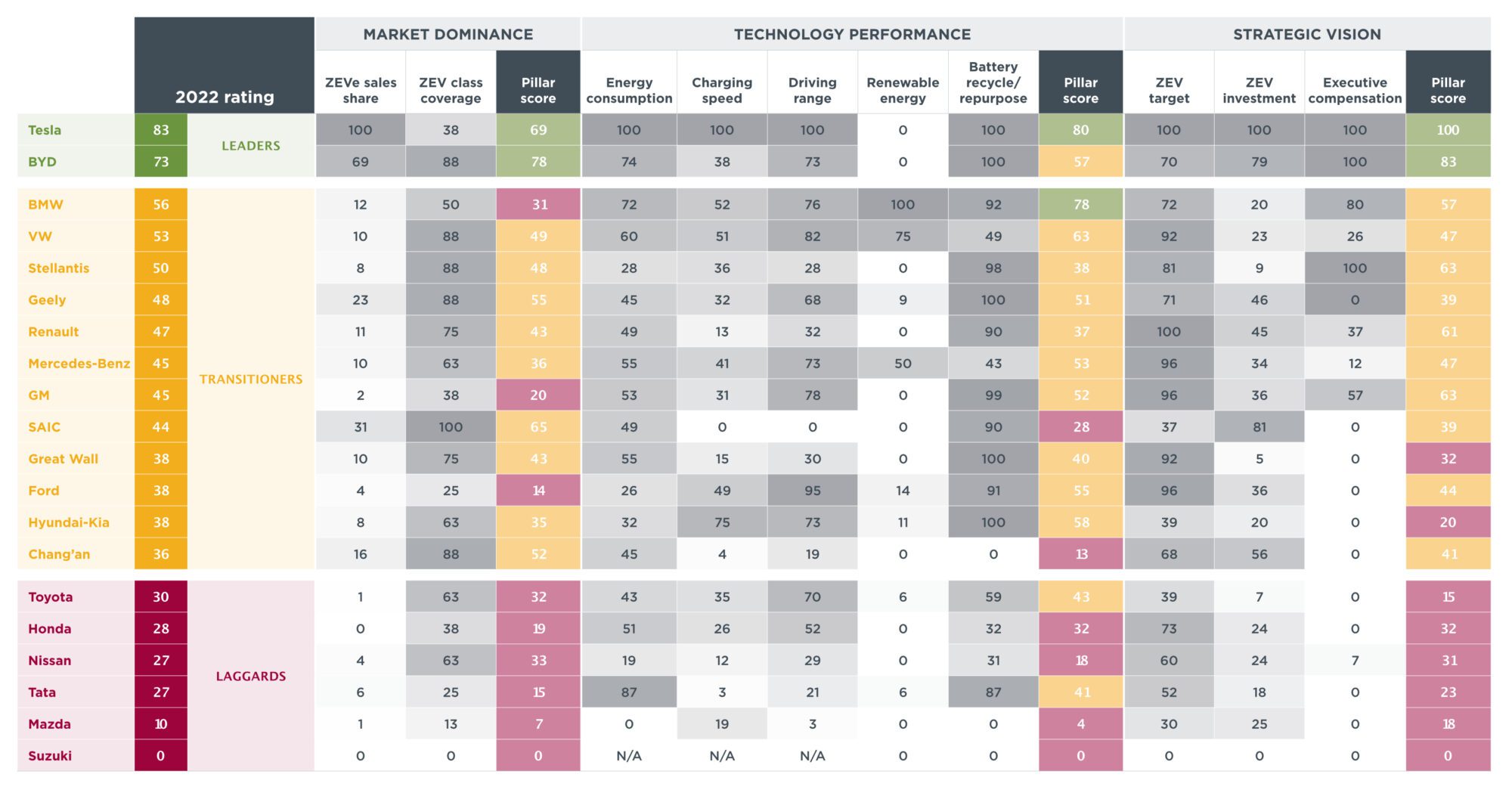The Global Automaker Rating 2022: Who is leading the transition to electric vehicles?
Blog
Under the hood: Some automakers are surprising in the EV race
In the high-stakes race away from conventional internal combustion engine vehicles and toward a zero-tailpipe-emissions future, the traditional hierarchies among light-duty vehicle (LDV) manufacturers are ripe for reshuffling. Indeed, our recent report, The Global Automaker Rating 2022: Who is Leading the Transition to Electric Vehicles?, lifted the hood of the LDV industry and delivered some findings about automaker progress that you might find surprising. We focused on the world’s 20 largest auto manufacturers by LDV sales and rated them on three pillars: market dominance, technology performance, and strategic vision.

Table. Overall scores, The Global Automaker Rating 2022
An automaker you might not know well captured second place. BYD, a relatively new player in the automobile market as it’s been making cars only since 1995, is a frontrunner in the rating, second behind Tesla. After debuting its first electric vehicle (EV), the BYD e6, in 2009, this China-headquartered automaker made a substantial leap forward in March 2022 when it committed to manufacturing exclusively battery electric vehicles (BEVs) and plug-in hybrid electric vehicles (PHEVs). For the full year 2022, the company saw a 26 percentage point surge in the share of EVs in its total LDV sales, and that share reached 99%. Although BYD is the first conventional manufacturer to convert to selling only EVs, about half of the EVs it sold in 2022 were PHEVs, which contain an internal combustion engine and generate tailpipe pollution when burning fossil fuels. Thus, BYD has still not achieved a full transition to zero-emission vehicles (ZEVs) at the tailpipe.
Neither GM nor Ford was the top U.S.-headquartered automaker. Stellantis, parent company of Chrysler, which is often grouped with GM and Ford as the American “Big Three,” edged out Ford and GM. While Stellantis performed below average in technology performance, its executive compensation package stood out. Of the 18 automakers on the list that aren’t producing 100% EVs, only five have tied EV progress to their executive compensation structure. Stellantis has the highest share of compensation that directly or indirectly links to EV development, including a transformation incentive from 2021 to 2025 that’s roughly 22% of the Stellantis CEO’s annual compensation and it’s determined by a set of milestones related to EVs and other technology targets such as autonomous vehicle technology.
GM was rated slightly higher than Ford. Although long-time rivals GM and Ford exhibited similar performance in the ZEV transition, GM managed to inch past Ford, largely thanks to more robust strategic vision. GM has integrated an EV component in its executive compensation since 2022 and it now accounts for approximately 11% of the total; most of the overall score difference between the two giants is attributable to this. On other metrics, the automakers showed similar performance. Both have a low EV share of sales and a limited variety of ZEV models. Both received an overall score below 50 and thus have ample room for improvement, including in areas such as vehicle performance, upstream decarbonization including using renewable energy in manufacturing, and battery recycling.
SAIC has China’s strongest-selling EV, the Wuling Hongguang, but was rated behind two other automakers headquartered in China. SAIC was strong on some metrics; it had the third highest ZEV market share (30%) behind Tesla and BYD, offered ZEV models across all eight LDV classes, and showed solid commitment to ZEV investment. However, its overall score of 44 reflects lagging vehicle performance, largely due to its strategy of focusing on less expensive BEVs designed for urban dwellers’ daily commutes. Its popular models, while attractively priced, often come with limitations in driving range and fast charging capacity.
Makers of esteemed BEV models the IONIQ (Hyundai-Kia) and the Leaf (Nissan) lagged, with overall scores of only 38 and 27, respectively. Hyundai-Kia’s rating left it in the lower echelon of the “transitioner” category and Nissan was in the “laggard” category. Both automakers scored low on market dominance, with low ZEV sales shares and a lack of variety in their ZEV offerings. In terms of ZEV performance, Hyundai-Kia earned a low score for energy consumption and Nissan showed a need to step up its game across various metrics, including energy consumption, driving range, and charging speed, if it is to improve in future ratings. Both automakers scored low on their use of renewable energy in manufacturing and had much weaker strategic vision compared to Europe- and U.S.-headquartered competitors; global EV targets for 2030 of 36% for Hyundai, 30% for Kia, and 50% for Nissan and their committed investment toward these goals were at the lower end of the spectrum.
Toyota was among the laggards. Toyota, the world’s largest automaker, was rated a “laggard” and was noticeably behind in its strategic vision. Our 2022 rating covered announcements through the end of that year, but in April 2023, Toyota made headlines when it announced a goal to sell 1.5 million EVs annually by 2026. This drew recognition from the White House, but when looking under the hood, we see that this announcement only serves as a mid-term target that puts Toyota on track to meet its previously set target of 3.5 million BEV sales annually by 2030. That target, which we projected would result in a ZEV market share of approximately 32% by 2030, placed Toyota in the bottom five in the ZEV target metric. Toyota did not fare well on technology performance, either. Despite being a pioneer and leader in hybrid vehicle technology with its much-admired Prius (which later also offered a PHEV version), Toyota’s performance in ZEV deployment lagged, in part because of the lack of an ambitious strategy and relatively small ZEV investment.
The only India-headquartered manufacturer on the list was among the laggards. Although Tata Motors dominates India’s EV market with an 80% share, the automaker received an overall score of 27 and was in the “laggard” group. While Tata Motors subsidiaries Jaguar and Land Rover have notably bold targets for ZEVs—they aim for a complete transition by 2025 and 2035, respectively—the primary Tata brand has set only a modest ZEV share target of 30% by 2030. The automaker also has room to improve in terms of ZEV sales share (6%) and the diversity of ZEV models it offers. Besides SUVs, the automaker currently only offers ZEVs in the subcompact car class. As one of the largest automakers in India, Tata can be more proactive in leading this transition and would score higher in future ratings if it sets ambitious ZEV targets, introduces a wider variety of models, and increases investment to enhance vehicle performance.
Of the 20 automakers analyzed, 15 scored below 50 and there is considerable opportunity for industry-wide improvement. The findings also emphasize that in the race toward an electric future, it’s not enough to be a sprinter in one field while lagging in others.
The 10 metrics evaluated in the report offer key insights into various aspects of leadership in this transition. As better data becomes available, future editions of The Global Automaker Rating will refine these metrics and monitor if automaker commitments are being met. This will equip consumers, investors, and manufacturers with timely insights and enhance understanding of which automakers lead the field and the underlying reasons behind their progress.

